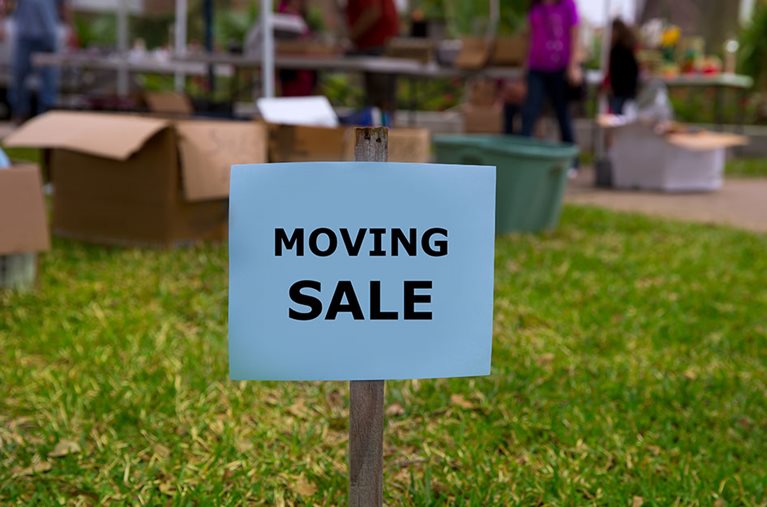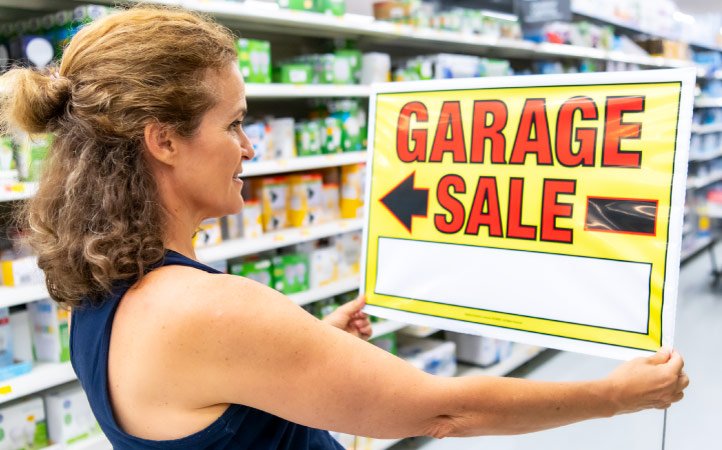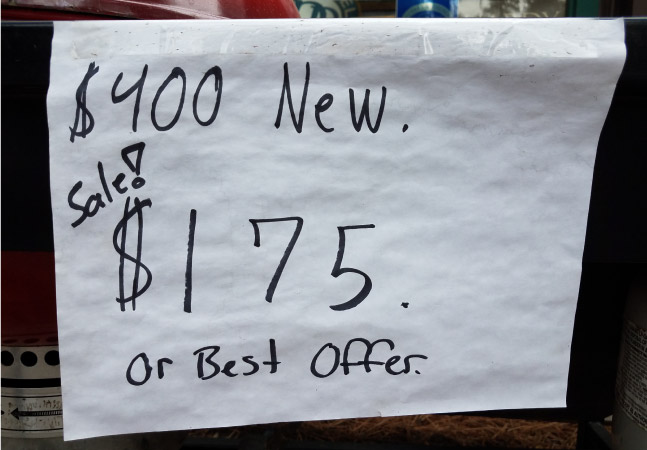
Moving Sale 101: How To Have a Winning Pre-Move Yard Sale
Moving Tips and Hacks
How To Prepare For Your Moving Sale
As you can imagine, a moving sale is a great way to offload your unneeded/unwanted/unusable items, say goodbye to your neighbors, and even make a quick buck! But it doesn’t just happen overnight — you have to make it happen. Read on for tips on how to prepare for, execute, and make the most of your moving sale — basically, everything there is to know about how to have a moving sale.
1. Set a Date (and Time).
Setting a date for your moving sale is a great motivator to get all the prep done well before your sale takes place. We recommend scheduling it three to four weeks before your move date to give you time to get organized for the sale, advertise it, and still get all of your packing and loading done for your move (without stressing yourself out at the last minute).
In addition to picking a date for your sale, you’re going to want a specific start time. Most garage sales start early — we’re talking 7 A.M. — but if you want to catch the more serious garage-sale crowd, starting yours at 6:30 A.M. is a good idea.
2. Check the Local Rules and Regulations for Moving Sales.
Some cities, towns, and even neighborhoods have regulations that must be followed when it comes to yard sales, garage sales, etc. There may be a limit on the number of days you can run the sale, how much stuff you can sell, or even what kinds of things you can sell. And depending on where you live, you may be required to get a special permit and display that permit number on your signs. To avoid getting shut down, do your due diligence by researching your local rules and regulations to ensure you’ve got all your ducks in a row.
3. Decide What You’re Gonna Sell.
Picking and choosing what you want to sell may be the hardest part when it comes to preparing for your moving sale. When in doubt, do as Marie Kondo does and ask if each item sparks joy. If the answer is “no,” into the sell box it goes.
Apply this thought process to one category at a time and go item by item. Start in the kitchen with the appliances, dishes, and food storage containers, for instance. Then onto the kids’ rooms, your closets, the garage. If you focus on one type of thing (clothes, toys, etc.), it’s easier to really see what you have, what you need, and what you don’t want anymore. Anything that’s broken or has stains should be recycled, repurposed (old clothes make great rags), or thrown away.

Be sure to put a sticker on everything to make for easier tracking throughout your hectic sale — not to mention less questioning from potential buyers.
4. Price It Right.
The next step is to put a price on everything — and we mean everything. Boxes labeled “Everything $1” may seem like a good idea, but once an item leaves that box, it’s going to be hard to remember where it came from, so put a sticker on everything.
| Q: How do you price items for a moving sale? A: The general rule of thumb for a yard sale is to never sell any item for more than 10 percent of its retail price. An exception to this rule is luxury or brand-name items that are in great shape. You can safely price those at 20 percent of what you paid for them. Another good rule of thumb? Mark items in 5-cent increments to make giving change easier (cha-ching!). If you have larger items or antiques, consider having them professionally appraised. You’ll have a lot more confidence when haggling with experienced buyers, and they won’t be able to lowball you into oblivion. |
5. Bundle It Up.
Garage-sale goers are all about the bargains, and bundling similar items is a great way for you to give them bargains (and get rid of even more unwanted items). For example, you can bundle things such as DVDs, CDs, baby clothes, and costume jewelry. You may get a little less money per item, but you’ll likely sell more in the long run — which is definitely better than selling less. Remember: The point is to get rid of things.
6. Sort All of Your Items.
Before the big day, get your sale items in order — like things with other like things. This is going to make setting up your sale much easier. If you have space in your garage, you can even set displays up on folding tables so all you need to do is pull them out on the day of.
| Pro Tip: If you don’t have a garage with extra space for prepping your moving sale, you can rent a PODS portable storage container instead. Have it delivered right to your driveway, where you can use it as a staging area to organize your moving sale items. When you’re done offloading your excess belongings, you can use it for your move! Simply load the container with your packed boxes and furniture, and PODS will pick it up and deliver it to your new home. Two birds with one stone, anyone? |

Whether you hang signs around your neighborhood, spread the word through friends, or post on social media (or all three), marketing your garage sale is crucial for ensuring a good turnout!
7. Advertise, Advertise, Advertise.
At least a week before your moving sale, post signs in and around your neighborhood that clearly state where and when your sale will take place (if your local rules and regs allow it). Also post notices online with photos of your best wares. Start with your own Facebook page, but also be sure to post in local FB garage sale groups, Facebook Marketplace, OfferUp, and Craigslist.
| Pro Tip: Make sure you’re advertising the right thing! Sales aren’t one-size-fits-all, and it’s important to know what differentiates a moving sale vs. garage sale vs. estate sale to help buyers know what they can expect. What is an estate sale vs. garage sale, you ask? The easiest way to distinguish between them is formality. A garage sale is typically pretty lax and can involve friends, family, or some other group purging items from their homes. An estate sale, however, is a lot more formal. They’re meant to sell off a late family member’s belongings, and might contain fancier items than your typical garage sale. They’re also a lot larger than garage sales. Organizing a garage sale isn’t nearly as stressful, and there might not be as many moving parts. You’re usually selling your own items, and it’s all in your own yard, so pricing, haggling, and choosing what to sell is a lot easier. Planning an estate sale, however, can be the opposite experience. They’re larger, and can often include antiques and larger items, so shoppers are likely to look for fancier items (and be willing to shell out more money for them). Getting a professional appraisal is often recommended. On the other hand, what is the meaning of a moving sale? They’re basically the same as a garage sale, except here, you’re selling items to downsize for a move, not to simply purge. A moving out sale is a great way to say goodbye to your neighbors while making your move easier altogether. Other than that, organizing one is pretty similar to a garage sale. |
8. Get Ready To Get Paid.
In today’s technological world, cards are king and cash is (nearly) a thing of the past. At a yard sale, however, you should prepare for both. There are various “digital wallet” apps that you can download that make payments between users easy, as well (CashApp, Venmo, and PayPal, to name a few). Square is a popular option for card transactions, and — of course — you can’t go wrong with a fanny pack with cash for those old-school garage-salers. Our advice? Hang up a sign that clearly identifies the different forms of payment you’ll accept.
| Q: How much change should I have for my moving sale? A: We recommend having $100 in cash at the start of your moving sale. This should keep you from having to run out to the ATM and is also an easy baseline to calculate profits from. Here’s a good way to divide it up to cover your change-making bases: — 20 x $1 bills — 5 x $5 bills — 4 x $10 bills — 1 roll of quarters — 1 roll of dimes Depending on how you decide to price your items (increments of 5 cents, 10 cents, $1, etc.), you may need a roll of nickels or no coins at all. |
The Day of Your Moving Sale
As we mentioned before, yard sales start early. You’re going to want to have everything ready to roll the night before, so you can start making that sweet, sweet moving-sale moolah ASAP. If you’ve done it right, all you should have to do in the morning is pour yourself a cup o’ joe, open your garage (or moving container), pull out your tables and boxes of organized and priced items, and strap on your fanny pack. Once the bargain hunters start going through your things, though, there will be more to occupy your time than simply counting greenbacks. Here’s what you should be doing during your moving sale.
| Pro Tip: If you have a coffee pot that works on a timer, set that thing to brew at 5:30 A.M., so you can be up and at ’em in time to catch those sunrise sale seekers. |
1. Attract Attention.
Many garage-sale goers drive from sale to sale looking for a promising spread of second-hand goods. If your items aren’t displayed in an attention-grabbing way, they may not stop to check them out. Attract attention by arranging your items in a way that makes sense. Put like things with like things, place larger furniture pieces out where everyone can see them, post signs to direct attention to different category items (clothes, electronics, toys, etc.). And as items are sold and space is freed up, be sure to move things around to keep your sale looking full.
| Q: How do I organize my moving sale? A: Think like you’re the manager of a department store and organize by room or category. If you have the extra space, you can even get creative with some staging to attract buyers (you might be surprised about what people are willing to pay just because an item is presented nicely). Place kitchen appliances on one table, toys on another, and clothes on their own rack or shelf. This will make it easy for shoppers to go through items — and for them to leave with more than one item in their arms. |

Learn the lingo before your sale to make negotiations easier on both you and buyers — confidence is key to securing sales!
2. Be Flexible With Your Pricing.
A lot of people come to moving sales expecting a huge bargain. When items are priced too high, they may not sell at all (which is worse than selling cheaply). If you’re getting close to the end of your sale and still have a lot left over, or you notice an item is garnering interest but failing to sell, it may be time to drop the price. Keep a marker and labels on hand so you can adjust the prices accordingly, or consider adding “OBO” (shorthand for “Or Best Offer”) to the existing stickers and signs.
3. Learn How to Negotiate and Haggle.
Knowing how to haggle and negotiate is an important part of any moving sale. Everyone wants a deal, and you should expect some lower-than-sticker-price offers, so give yourself a little wiggle room when pricing your items. Negotiating is fine, but you don’t want to just give your things away for nothing, so watch out for lowballers!
4. Get the Family Involved.
If you have kids, chances are they also have a lot of extra toys and clothes they don’t need anymore. Invite them to price and display their items at the moving sale and let them keep the profits from whatever they sell. The extra spending money will be good motivation for them to cut down on the clutter in their rooms. And they’ll love the excitement of being sales associates for the day!
5. Make It Fun!
Speaking of your kids having fun, consider letting them set up a table with some cool summer drinks and snacks to share with your neighbors and shoppers who stop by. They’ll love the responsibility, and this will make the whole experience even more pleasant for you and for anyone checking out the goods. And did we mention that a moving sale is a great way to see your neighbors and say your goodbyes before heading to your new home?

When the sale is over and you’re left standing in your yard looking at the remaining items, consider listing them online, donating them to a local charity, or recycling anything that you can’t donate.
After Your Moving Sale
It’s unlikely you’ll sell everything at your moving sale, but hopefully you’ll manage to offload most of it and make a nice chunk of change in the process. When the sale is over and you’re left standing in your yard looking at the remaining odds and ends, here are a few things you can do to wrap everything up.
1. List Furniture and Other More Valuable Items Online.
You can use eBay, OfferUp, or numerous other online marketplaces, but Facebook Marketplace is probably your best bet. There, you can list anything from clothing, electronics, and bedding to furniture and outdoor equipment. It only takes a few minutes to create a listing, and the community is huge. Pro Tip: Before deciding on an asking price, see what similar items are being listed for and then ask for less.
2. Sell Your Clothes to a Used Clothing Store.
Clothes can be tricky to sell at a moving sale or online. A great option for any clothing that’s still in good shape is to bag it up and take it to a used clothing store like Plato’s Closet. They may not give you much for it, but something is better than nothing, and your clothes will get a second life instead of ending up at the dump.
3. Donate What You Can’t Sell.
After selling what you can, go ahead and take whatever’s left to Goodwill, the Salvation Army, or another similar charity. As long as your items are still in decent shape, they’ll find a use for them. And, as an added incentive, charitable donations to qualified organizations are tax deductible, so make sure you get a receipt.
4. Recycle or Toss Anything That You Can’t Donate.
After selling and donating everything, you’ll probably be left with some iffy items that clearly aren’t wanted by you (or anyone else). Look at what materials each thing is made of and recycle whatever your city will accept. As for the rest? Toss it in the garbage can.
Get Ready For Your Big Move
Now that you’ve reduced your worldly belongings to things you actually want, it’s time to start packing. Visit the PODS Blog for moving tips that’ll make you love (or only semi-dislike) packing and other helpful advice.
Related Articles
Comments
Leave a Comment
Your email address will not be published. Required fields are marked *
